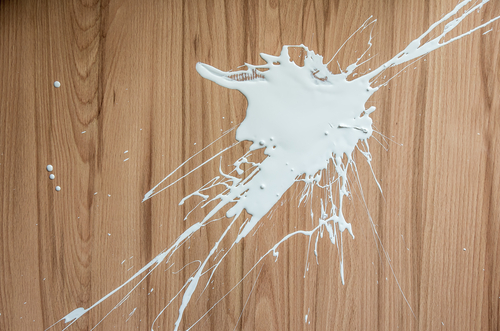
How to Clean Paint Spills and Drips off Wood Floors
Paint is a transformative medium. With just a brush and a can of paint, you can dramatically change the look of a room or create a masterpiece on canvas. Unfortunately, the paint often lands in spots it shouldn’t, including on wood floors.
Ideally, you catch the problem immediately and use a rag to wipe the paint off the wood floor while it is still damp. Usually, though, you find the drip only after it has dried. With just a few supplies and a little patience, you can usually remove the paint without damaging the floor.
Stripping paint from wood furniture or surfaces is a much bigger undertaking that involves sanding, a chemical stripper, or using dry heat or steam. If you’re tackling a DIY project, be prepared to spend some time and elbow grease to strip away the paint so the item can be restored.
To remove some splatters or even a larger spill from a painting project, follow these steps to enjoy paint-free floors. Always begin with the most gentle method (soap and water) and work your way to the more harsh cleaning products.
What You’ll Need
Equipment / Tools
- Microfiber cloth
- Rags
- Hard plastic putty knife
- Small bowl
- Old toothbrush or nylon-bristle scrub brush
- Hairdryer or heat gun
Materials
- Cotton ball
- Isopropyl (rubbing) alcohol
- Dishwashing liquid
- Lemon juice
- Chemical paint stripper
- Mineral spirits or paint thinner
Instructions
01. Test the Paint
If you have caused the paint splatters yourself, you most likely know whether they were caused by water-based or oil-based paint. If you didn’t make the mess, you can test the paint to determine the easiest removal steps.
- Wet a cotton ball with isopropyl (rubbing) alcohol.
- Wipe it over the paint splatter.
- Check the cotton ball for paint residue. If there is none, the paint splatter is oil-based. If there is residue, then the splatters are water-based or latex paint, which is usually easier to remove.
02. Apply Dishwashing Liquid and Water
If you have determined that the paint is water-based, mix a few drops of dishwashing liquid in two cups of very warm water. Dip a microfiber cloth in the solution and wring until just damp. Working in the direction of the wood grain, scrub the paint-splattered area. As the paint loosens, wipe it away with a dry rag.
If the paint feels loose but is not coming off, use a hard plastic putty knife or the edge of a credit card to gently scrape it away. Don’t use too much pressure, or you can scratch the floor.
03. Try Isopropyl Alcohol and Lemon Juice
If soap and water didn’t work, mix a solution of three parts isopropyl (rubbing) alcohol and one part lemon juice in a small bowl. Begin by carefully scraping off as much of the paint as possible with a putty knife without harming the floor finish.
Dip a rag into the alcohol mixture and place the rag over the paint spatters and allow it to sit for five minutes. Use the damp rag to scrub away the loosened paint. If the paint still won’t budge, dip an old toothbrush or small nylon-bristled scrub brush in the solution and scrub away the paint. Finish by wiping the area with a rag dipped in clean water and wrung until just damp. Use a dry microfiber towel to buff the floor finish.
04. Apply Heat
If the paint still won’t budge, use heat to soften the paint and follow up with the soap and water steps. A heat gun aimed at the splatters works well to soften the paint so it can be lifted with a putty knife. Since a heat gun can also melt the finish on the wood floor if used in one spot for too long, take care to work quickly. A handheld hair dryer is a good option to prevent overheating the floor.
05. Use Paint Remover or Paint Thinner
If the paint hasn’t budged or it is oil-based, you will need to use a paint remover or paint thinner (turpentine or mineral spirits). Make sure the room is well-ventilated and there are no open flames from fireplaces or candles


Leave a Reply